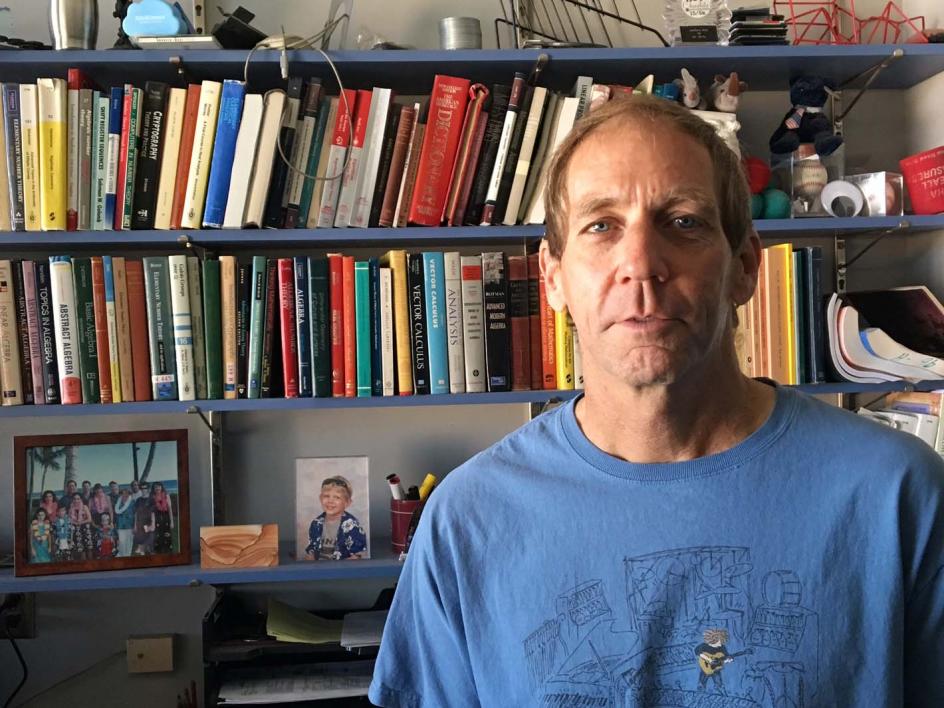Researchers announce new way to explore mathematical universe

A Maass form, one of the 20 different types of objects in the LMFDB. Image by Fredrik Streoemberg
An international group of mathematicians at Arizona State University and other institutions have released a new kind of online resource to help discover uncharted mathematical worlds.
The “L-functions and Modular Forms Database,” or LMFDB, is an intricate catalog of mathematical objects and the connections between them. Both beautiful and functional like an atlas, the LMFDB reveals deep relationships and provides a guide to previously uncharted territory that underlies current research in several branches of physics, computer science and mathematics. This coordinated effort is part of a massive collaboration of researchers around the globe, and includes developing new algorithms and performing large calculations on an extensive network of computers.
"We are mapping the mathematics of the 21st century," said project member Brian Conrey, director of the American Institute of Mathematics. "The LMFDB is both an educational resource and a research tool, one that will become indispensable for future exploration."
Massive computations
The scale of the computational effort that went into creating the LMFDB is staggering: a total of nearly a thousand years of computer time spent on calculations by multiple teams of researchers. One recent computation used more than 72,000 cores of Google's Compute Engine to complete a tabulation in one weekend that would have taken more than a century on a single computer. The objects in the LMFDB are all connected to the area of mathematics known as number theory. Related computations are often amenable to massive parallelization, and this allows for scaling to the cloud. Some of the calculations are so intricate that only a handful of experts know how to do them, and some are so big that it makes sense to run them only once, and then share the (verified) results.
"Many of us have made extensive computations, and we wanted to make this data available to other researchers and to link these projects together to aid mathematical progress. By joining forces, we now have a site for one-stop shopping of big data," said LMFDB project member John Jones, a professor of mathematics in the School of Mathematical and Statistical Sciences at Arizona State University.
ASU professor John Jones is a pioneer in providing mathematical data via the web. Starting in the 1990s, he wrote a series of papers with David Roberts of the University of Minnesota at Morris on techniques for novel number theoretic computations, and would provide results on his website. Since 2011, he has been a regular contributor to the LMFDB. Photo by Rhonda Olson/ASU
Mathematical interconnections
Large-scale cloud computing is just one of the ways in which the project is changing the way mathematics research is done. The LMFDB provides a sophisticated web interface that allows both experts and amateurs to easily navigate its contents. Each object has a “home page” and links to related objects, or “friends.”
Just like explorers, mathematicians become excited when they discover a connection between two areas that at first appear to be unrelated. The discovery leads to further breakthroughs in research when those connections are made explicit. Researchers following different paths may be heading toward the same destination, but unless they communicate with each other, the explorers on those paths may not realize how close they are.
The LMFDB includes researchers from more than a dozen areas, all of whom are building connections between their seemingly separate specialties.
“Each mathematician is an expert in their own area and knows one path really well, but the LMFDB helps to demystify the other paths by providing the possible interconnections in clear and navigable terms. It opens up a whole new world of possibilities for mathematical research,” said Jones.
The LMFDB also includes an integrated knowledge database that further clarifies relationships to mathematicians by explaining the contents of the site and the mathematics behind it.
Uses for today’s high-tech world
All mathematics is eventually useful. One of the great triumphs in mathematics of the late 20th century was achieved by British number theorist Andrew Wiles with his proof of Fermat’s Last Theorem, a famous proposition by Pierre de Fermat that went unproven for more than 350 years despite the efforts of generations of mathematicians. The proof has been the subject of several documentaries, and it earned Wiles the Abel Prize earlier this year.
The essence of Wiles' proof was establishing a long-conjectured relationship between two mathematical worlds: elliptic curves and modular forms. Elliptic curves arise naturally in many parts of mathematics and can be described by simple cubic equations; they also form the basis of cryptographic protocols used by most of the major internet companies, including Google, Facebook and Amazon. Modular forms are more mysterious objects: complex functions with an almost unbelievable degree of symmetry. Elliptic curves and modular forms are connected via their L-functions. The remarkable relationship between elliptic curves and modular forms established by Wiles is made fully explicit in the LMFDB, where one can travel from one world to another with the click of a mouse and view the L-functions that connect the two worlds.
A team effort
There will be several simultaneous events happening May 10 in North America and Europe to celebrate the launch of the LMFDB, including public presentations and lectures at the American Institute for Mathematics in San Jose, California; Dartmouth College in Hanover, New Hampshire; and the University of Bristol in the United Kingdom.
The LMFDB project has been funded by the U.S. National Science Foundation, the UK Engineering and Physical Sciences Research Council, the American Institute of Mathematics, the EU 2020 Horizon OpenDreamKit Project, and the Institute for Computational and Experimental Research in Mathematics, and it involves researchers from Arizona State University, Dartmouth College, MIT, Oregon State University, the University of Bristol, the University of California at San Diego, the University of Paris, the University of Sydney, the University of Warwick, the University of Waterloo and other institutions.
More Science and technology
Statewide initiative to speed transfer of ASU lab research to marketplace
A new initiative will help speed the time it takes for groundbreaking biomedical research at Arizona’s three public universities…

ASU research seeks solutions to challenges faced by middle-aged adults
Adults in midlife comprise a large percentage of the country’s population — 24 percent of Arizonans are between 45 and 65 years…

ASU research helps prevent substance abuse, mental health problems and more
Smoking rates among teenagers today are much lower than they were a generation ago, decreasing from 36% in the late 1990s to…


